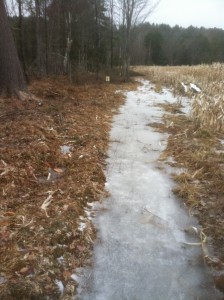Ice Hiking
On a recent cold morning my wife, Ann, and I waited for the temperature to rise from minus 12 as we contemplated a winter hike. At 10 above we added a few layers and put a canteen of warm water, a snack and our upgraded pull-on crampons in a small backpack – enough for a couple of hours of hiking. We started on a well worn path and with a few turns were the first footprints in the snow which always adds to the fun. We knew many trails were icy but the last snow, which had seen warmer days, covered the ice with a crusty layer and was not slippery. I went bare boot and Ann tried out her new ‘micro-spikes’. Neither of us had a problem that day but Ann was confident and I was careful.
A week earlier on the trail, without the pack full of supplies, we were surprised at the amount of trail ice we saw. Lots of black ice located where a slip could send you down a rocky slope or splashing into the Ompompanoosuc River! That day we kept going but went off trail to get around the ice – in one spot bushwhacking for about a quarter of a mile. It is important to note that when the ground is frozen going off trail causes no damage (as it would after the spring thaw) and is a lot safer. Even with her ‘micro-spikes’ Ann does not cross any sloping sheet of ice or hike up the middle of an icy uphill trail. She doesn’t want to fall in those spots since much of today’s outerwear is made of pretty slippery stuff.
The combination of good gear and common sense will keep you safe on any trail and reduce the risk of falls and other dangers to near zero. The effort required for a hike on those wintry days is well repaid by the beauty of the snowy winter woods and ice framed streams and rivers. On our last hike, we had the bonus of seeing the tracks and slides in the snow where an otter had circumvented rough spots in the river. Another bonus, of course, is that it’s good for body and soul.
J. Roger Hanlon, Trustee & Sunday Stroll Leader


